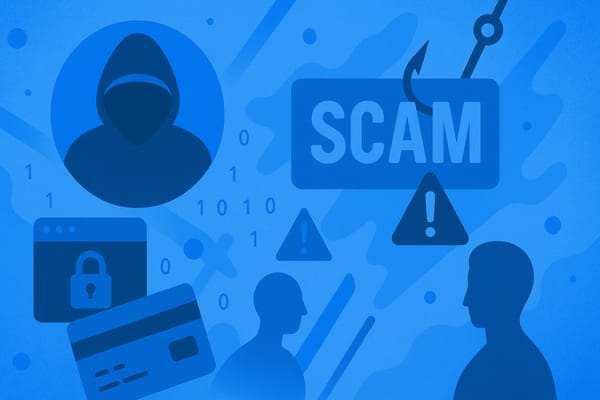ATO Impersonation Scams Rise 300% as Tax Season Starts in Australia

The Australian Taxation Office (ATO) is now accepting tax returns for the 2024–25 financial year. While you can lodge your return from July 1, the ATO actually recommends holding off until late July. That's when most of your income and interest details from employers, banks, and government agencies are prefilled, making it easier to file accurately. The best time to lodge is usually between mid-July and mid-August to avoid delays and reduce mistakes.
But as millions of Australians prepare their returns, scammers are already hard at work, flooding inboxes and phones with fake ATO or another reputable organisation messages. According to the ATO, impersonation email scams have surged by more than 300% compared to this time last year.
Why These ATO Scams Are So Convincing (and How They Trick You)
Jenny Wong, Tax Lead at CPA Australia, says scammers know people are thinking about their taxes and may be more likely to click on something that looks urgent. "The scammers know Australians will have tax on their mind and are vulnerable to prompts to act, which is why these messages usually create a sense of urgency or claim of a significant refund. While they could come at any time, be especially careful opening up and reading messages while you're still waking up in the morning," she explains.
The fake emails often:
- Promise a tax refund or warn that you've missed a payment
- Include an urgent call to action—like "log in now" or "click to avoid penalties"
- Provide a link to a fake website that looks official
Some messages claim there's an "urgent update" in your account inbox or ask you to check "official correspondence" or "benefit updates." Others pressure you to "keep checking your inbox" so you don't miss something important about your tax, pension, or other government services.
It's all designed to make you click without thinking—and hand over your personal info in the process.
The Cost of Letting Your Guard Down
The National Anti-Scam Centre reports that phishing scams are responsible for $13.7 million in losses in the first 4 months of 2025 in Australia — compared to $4.6 million in early 2024.
This kind of fraud doesn't just target individuals. If you're running a small business, scammers may target your inbox too—posing as the ATO, your accountant, or even one of your clients. A single click can expose sensitive information or infect your systems with malware.
How to Spot a Scam Message
Scam emails and texts are getting harder to detect—but there are still red flags:
- Weird grammar or American spellings like "organization" instead of "organisation"
- Links or QR codes in text messages — the ATO does not use them
- Suspicious email addresses with odd spellings or extra characters
- Urgent language asking for personal or financial details — the ATO never asks for passwords or account numbers over email or SMS
- Social media impersonators — check for a verified tick, and remember: the ATO won't discuss your private details on social media
When in doubt, go straight to the official ATO website or call 1800 008 540 to check if a message is real.
Related: Phishing Scams: How to Identify and Avoid Them
Use These Bitdefender Tools to Check If a Message Is a Scam
Here are a few free scam-fighting tools from Bitdefender you can use today:
- Bitdefender Scamio – A free, AI-powered chatbot. Just copy and paste any suspicious message or link via WhatsApp, Messenger, or Discord, and Scamio will tell you if it's legit.
- Bitdefender Link Checker – Quickly check if a link is safe before you click.
- Real-Time Anti-Fraud and Anti-Phishing Filters. Integrated into Bitdefender's security products, these block phishing and scam websites before they ever load.
- Call Blocking for Android – Automatically blocks suspicious or spoofed calls and lets you create your own block list. Every scam call flagged helps protect the wider Bitdefender community.
- Bitdefender Ultimate Small Business Security – if you're filing your own taxes or managing returns for your business. It offers real-time scam and phishing protection, blocks dangerous websites, and helps safeguard your data—whether you're at home, at work, or on the go. Try it for free and make sure the only thing you're clicking on this tax season is your real refund.
Related: 'Your Account Has Been Hacked': Crypto and Bank Phishing Scams Surge Across Australia
tags
Author
Cristina is a freelance writer and a mother of two living in Denmark. Her 15 years experience in communication includes developing content for tv, online, mobile apps, and a chatbot.
View all postsRight now Top posts
Scammers Exploit Hype Around Starbucks Bearista Cup to Steal Data and Money, Bitdefender Antispam Lab Warns
November 18, 2025
Scam Alert: Fake Sephora Advent Calendar Ads and WhatsApp Messages Flood Europe in 2025
November 17, 2025
ClickFix Malware Chain Expands: Fake TradingView and Sora 2 Ads On Meta Now Target macOS Users
November 17, 2025
FOLLOW US ON SOCIAL MEDIA
You might also like
Bookmarks







